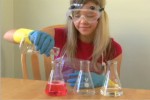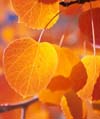What Materials In The Solution Caused The Color To Change?
Magic show or chemical science lab?
Sometimes it'southward hard to tell the difference!
Chemical reactions often produce spectacular color changes that appear to happen just by magic. At present is your chance to put some tricks up your sleeve and wow your friends with scientific sleight of manus.
(Notation: Some of the chemicals used in these projects tin be hazardous if misused. Use caution when working with chemicals! Read the data on the chemical characterization before yous start, and e'er wear protective lab prophylactic equipment such every bit goggles, gloves, and aprons. Adult supervision required.)
Bank check out our superlative-selling beginner chemistry prepare and home chemistry kit to perform classic experiments. Run across our consummate introduction to chemical science kit for a full overview of chemistry concepts and experiments.
Colour Modify Chemical Reactions Experiments + Video
#i – Confounding Color
Tin can yous get a liquid to change color simply by pouring information technology into some other container?
See this experiment in action before you try it!
What You lot Demand:
- 4 250 ml erlenmeyr flasks or 250 ml beakers
- Universal indicator
- Vinegar
- Ammonia
- Pipets
What Y'all Do:

one. Put 25 drops of universal indicator into the commencement flask, then add 200ml of water.
2. In the 2d flask, put a dropper-full of vinegar.
3. Add a dropper-full of ammonia to the third flask. (Be very careful not to breathe in the potent fumes from the ammonia!)
4. Put 100ml of vinegar in the fourth flask.
5. Slowly cascade the contents of the starting time flask into the second i, and so the 2nd into the third and the 3rd into the fourth.
What Happened:
The undercover of this magic colour change is pH. Chemicals with a low pH (0-6) are acidic, while those with a loftier pH (viii-fourteen) are basic. (A pH of seven is neutral: neither acidic nor basic.) Universal indicator is a chemic that changes color in the presence of acids and bases from a pH of 2 to 10. Acids turn the indicator red, pink, orangish, and yellowish, while bases plow it green, blueish, and majestic. Vinegar is an acid, then when you poured the indicator solution into the 2d flask, information technology turned cherry-red. Ammonia is a base, and then when y'all mixed the acidic vinegar solution with ammonia, it raised the pH and the h2o turned bluish. If you had enough vinegar in your concluding flask, the solution should have turned red once again. (If it didn't, attempt adding a lilliputian more vinegar.)
#2 – Mystery Pitcher
Tin can yous cascade red "kool-aid" out of a pitcher of water? Try information technology out and impress your audience – just don't drink the finished production!
Check out our project video to see this fob in activeness!
>> Get our Chemistry Magic Tricks Kit to do this project and 11 more!
What You Need:
- Phenolphthalein solution
- Sodium carbonate experiment powder
- Vinegar
- 5 glasses and a not-run across-through pitcher of h2o
What You Do:
1. In the first glass put a little less than ane/eight teaspoon of sodium carbonate, in the second put six drops of phenolphthalein solution, and in the third put 3 droppers-full of vinegar.
2. Add together a few drops of h2o to the first glass and stir to dissolve the sodium carbonate.
three. Fill all the glasses with water from the bullpen, and then pour all of them dorsum in the pitcher except for the glass with vinegar.
four. Refill the remaining four glasses – the water will be red!
5. At present pour all five glasses dorsum in the bullpen. Refill the glasses one concluding fourth dimension — the liquid volition be colorless again!
What Happened:
Like the universal indicator, phenolphthalein is a pH indicator, but it only turns colors in reaction to bases. When you poured the four glasses back into the pitcher, the phenolphthalein reacted to the sodium carbonate, a base, and turned the solution to cherry-red "kool-aid." To change it back to "water," all you had to do was add the acidic vinegar, which turned the phenolphthalein colorless again.
#3 – Invisible Ink
Invisible inks are as well chosen sympathetic inks, and can be made with many different substances. Sometimes they appear when you heat them upwards; other times another chemical tin can reveal them. Get creative and encounter how many kinds of invisible ink yous can find.
What Yous Need:
- You need Ink type 1 – lemon juice, grapefruit juice, vinegar, milk, onion juice
- Plus, Ink type 2 – cobalt chloride solution or cocl2
- Lastly, Ink blazon 3 – phenolphthalein, Windex
- Q-tips or paintbrush
What You Do:
one. Choose a liquid similar lemon juice to use as ink. Write a message on a piece of white paper using a paintbrush or q-tip, dipping in the ink frequently. Permit the message dry. Plough on the toaster and carefully hold your paper over information technology. The rut volition make your secret writing appear!
2. Some sympathetic inks appear and disappear again based on humidity. To effort one of these, make a solution of i/8 teaspoon cobalt chloride and 1/ii cup water. After writing your message and letting it dry, rut the paper to meet your message appear in blue. Now concur the paper confront down over a pan of steaming water. The steam will cause the writing to disappear. If you reheat it (evaporating all the water) the writing will appear again.
3. Other sympathetic inks work considering of acrid-base reactions. Employ phenolphthalein solution to write a message on a piece of newspaper and allow information technology dry. After it is dry, spray it with some Windex. Since Windex is a base of operations, it will turn the phenolphthalein bright pink.
What other sympathetic inks tin you find? Which kind shows up all-time? Which kind lasts longest?
#4 – Chromatography
Inks and dyes are by and large made up of a mixture of unlike colors. Chromatography is a process that lets you lot separate ink into its individual colors.
What You lot Demand:
- Filter newspaper (paper towels or coffee filters volition work too, but filter paper is best)
- Blackness mark or felt-tip pens, highlighters (non-main colors)
- Food coloring pack
- Several drinking glasses
- Many pencils
What Y'all Exercise:
1. Cut several strips of filter paper about a half-inch broad. Depict a big dot about a half-inch from the lesser of one of the strips with 1 of the markers or pens you want to test. Practise the same thing on different strips for each pen you desire to examination.
ii. Tape the strip to a pencil so that when the pencil rests across the cup the strip will hang down into the cup.
3. Cascade water into each cup until it is just barely touching the bottom of the paper strip. Go out the strip hanging in the water until the color has traveled most of the way upwards the strip.

What Happened:
Every bit the h2o creeps up the absorbent paper, it carries the color with it. Some components of the ink travel farther than others, causing the dissimilar colors to spread out so y'all tin see them. How many colors do you come across? Practice the different brands of pens accept different colors?
Many dyes are also made up of multiple colors. Endeavour a chromatography experiment with some food coloring. Place a drib of nutrient coloring in some water and hang a filter paper strip so it just barely touches the water. Does it carve up into colors? Effort mixing more one colour of food coloring and then see if you can separate them again with chromatography.
You lot can too do chromatography with permanent pens and markers; you lot'll simply demand to employ a different solvent, since those inks don't dissolve in water. Try isopropyl (rubbing) alcohol xc% or boom polish remover.
Get our chromatography kit for all the materials you need for fun chromatography projects.
Annual Color Change Chemical Reaction Experiments
Changing Leaves

Every fall we spotter amazing chemistry color changes happen all effectually u.s.a.. Copse that were green all year suddenly become bright yellow, orange, red, or even purple! How does this happen?
There are three types of chemical colour pigments in green leaves: chlorophyll, carotenoids, and anthocyanins.
Chlorophyll is the ascendant light-green paint used throughout the summer in the production of food past photosynthesis.
Carotenoids are pigments that give yellow, orange, or brownish colors and are present all summertime. Anthocyanins cause reds and purples and are produced in the fall.
During the summertime months, the leaves are so total of chlorophyll that green overpowers any other colors present in the leaves, such as yellow and orangish. Even though carotenoids may be nowadays in the leaves, we can't see them because the chlorophyll is so strong.
In the fall the days beginning to get shorter and the temperature drops, signaling to the tree that it is time to go into storage style for the wintertime. The chlorophyll starts to intermission down, causing the greenish in the leaves to disappear, and assuasive united states to run into the colors of the carotenoids, which were present all along. Virtually of the sugars and starches produced by the chlorophyll in the leaves are brought back into the tree, just when excess sugar is left in the leaves, anthocyanins are produced. (Vivid light also helps to class these red pigments.)
Eventually a separation layer of cells builds upwardly where the leaf is continued to the branch of the tree, blocking the transport of sugars from the leaf to the tree. When this layer is complete, the wind or the weight of the leaves themselves will cause the leaves to fall from the tree. Beneath the tree the layer of fallen leaves decomposes throughout the winter, returning nutrients back to the soil, which makes the topsoil fertile for more plants to grow in the next year.
Explore the pigments inside a light-green leafage past doing a leaf chromatography experiment! The setup is similar to the chromatography project above, but this fourth dimension you use rubbing alcohol to assistance pause down the chlorophyll.
Source: https://learning-center.homesciencetools.com/article/color-change-chemistry/
Posted by: provostgrou1956.blogspot.com

0 Response to "What Materials In The Solution Caused The Color To Change?"
Post a Comment